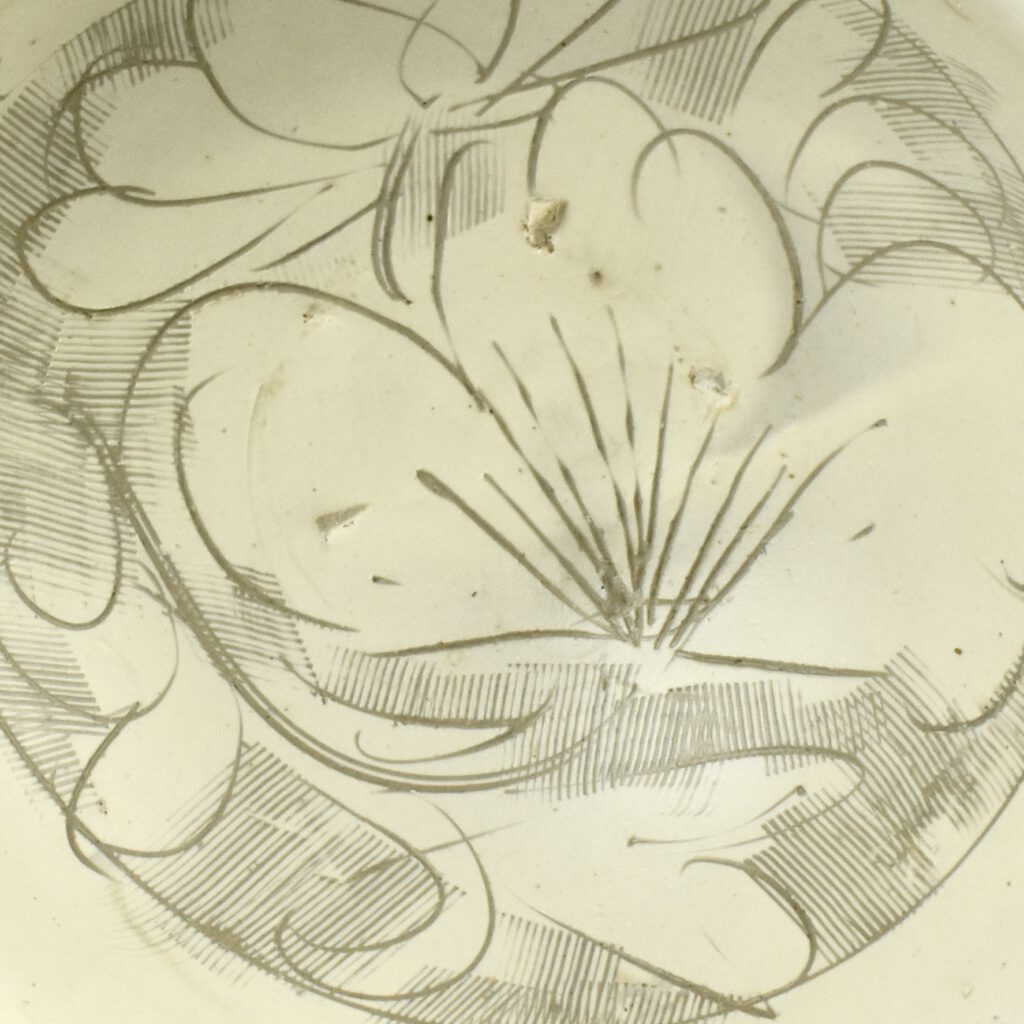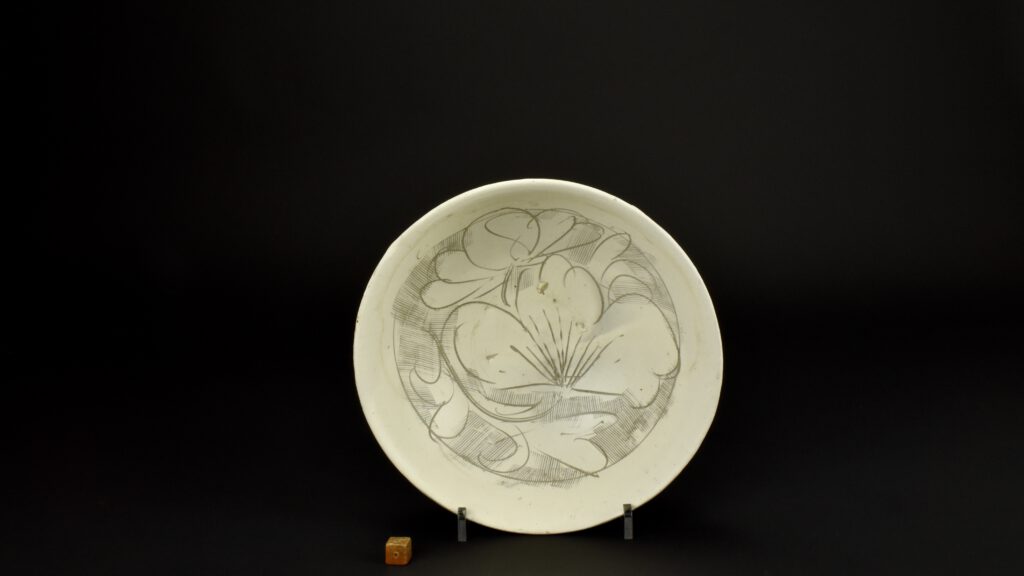
A Carved and Combed Cizhou Type Bowl, Northern Song c.12th Century
A Cizhou Type Carved and Combed Stoneware Bowl, Northern Song c.12th Century, probably from the Guantai kilns in Handanxian or a kiln Hebiji, Tanqyinxian. The stoneware bowl with sgraffito decoration of open peony flowers that overshoot the single incised border line. The putty-grey coloured stoneware body has a creamy white slip applied that has been fluidly incised using a stylus and a comb. The piece was then given an uneven thin clear glaze, the dipped slip is also somewhat uneven in depth. There are spur-marks visible to the well of the bowl and as grey shadows on the footrim from the kiln furniture. These bowls were piled up, they must have had a group sagger, rather than individual one.
See Below For More Photographs and Information.
SOLD
- Condition
- In excellent condition, there are a few small chips to the foot, these appear to be firing faults. The glaze is rather thin and appears dry. I think this piece was excavated.
- Size
- Diameter : 21 cm (8 1/3 inches). Depth 7.9 cm (3.1 inches)
- Provenance
- Purchased in Japan.
- Stock number
- 26395
- References
- References : For a similar Cizhou bowl dated to the Northern Song excavated at the Hebiji Kiln site in Hebi in 1963 see : Ceramic Finds From Henan (Exhibition catalogue for an exhibition presented by the University Museum and Art Gallery and Henan Institute of Cultural Relics and Archaeology, March 1997. ISBN 962-8038-13-3) page 92, plate 63. For a similar Cizhou bowl dated to Northern Song excavated at the Hebiji Kiln site in Hebi in 1963 containing a central inscription reading "Liu Jia Ci Qi" (Porcellanous ware made by the Liu Company) see : Ceramic Finds From Henan (Exhibition catalogue for an exhibition presented by the University Museum and Art Gallery and Henan Institute of Cultural Relics and Archaeology, March 1997. ISBN 962-8038-13-3) page 91, plate 62. Several bowls of this type are illustrated in : Freedom of Clay and Brush through Seven Centuries in Northern China ; Tz'u-chou Type Wares 960-1600 ( Yutaka Mino, Indiana University Press. ISBN 0-253-25575-6) page 92, the closed to the present bowl is Figure 77 from a Japanese collection. For a Cizhou Bowl of the Same Type See : Yuegutang, A Collection of Chinese Ceramics in Berlin (Regina Krahl, G+H Verlag Berlin,2000) Item 161 Page 204. For another Cizhou Pottery Bowl of this type see : Sotheby`s `Fine Chinese Ceramics and Works of Art, London, 13th December 1988, Lot 135. A similar bowl from the Selinka Collection was included in the Exhibition Chinesische Keramik, Cologne 1988, catalogue number 36. Compare also the bowl carved with two sprays of lotus on a similar ground. A bowl was found at the Guantai kiln site in Handanxian and a fragment unearthed at Hebiji in Tanqyinxian. A very similar Cizhou bowl, described as Jin Dynasty 12th Century, from the John Drew Collection was sold by us, see our `Sold Items` number 18576, and 24247.
Information
Cizhou Wares
A freedom of expression exists in Cizhou ware that is unparalleled by other Song dynasty (960-1279) ceramics. This was a direct result of not being under the control of the court; consequently, the liberty to explore and experiment created an innovative range of designs full of flavour and life unique to Cizhou ware. The utilization of enamelled decorations in tones of vivid reds, yellows, and greens on occasional Cizhou pieces placed it centuries ahead of its time as this was not kosher for early court wares. The ware also displays an amazing dexterity in the sketchily incised patterns which have such a sense of carefree abandon that they appear impressionistic. Today, Cizhou ware is prized for its natural appearance which often reveals the potter’s process from the wheel’s rings, to the inner spur marks, to the unevenly glazed base.
The white stonewares of the Tang dynasty (618-906) produced two extremely influential wares; the first, Ding ware, became the official ware while the second, Cizhou, became the “popular ware” among the varying classes. It was Cizhou ware’s utilization by society that assured its continuance during political and dynastic changes which extinguished other Song wares; consequently, Cizhou ware is still produced today though the wares created during the Song dynasty are considered to possess an unrivalled spirit. Since Cizhou ware embodies a diverse range of wares not confined to a specific location, kiln complex, or style it is difficult to precisely define its characteristics.
The name Cizhou originated from the ancient area of Cizhou, encompassing a broad arc across China, which was first recorded during the Sui dynasty (581-618). However, the location constantly shifted and though the area of Cizhou is mentioned in the Tang dynasty (618-906) and Five Dynasties (906-960), each referred to an altered location.During the Song, Jin (1125-1234), Yuan (1279-1368), and partly into the Ming dynasties (1368-1644) the kiln areas of Cizhou were primarily concentrated in the northern provinces of Hebei, Henan, and Shaanxi. (By Mindy MacDonald).
The Fitzwilliam Museum, Cambridge.
Given by Oscar Raphael in 1936.

Sold at Christie's New York










